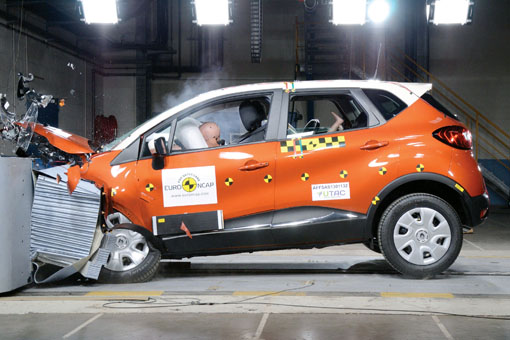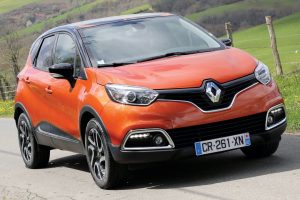Renault Captur-s another five-star NCAP award

RENAULT has been awarded the latest in a long line of five-star NCAP safety ratings. This time it is for its Captur model.
The Captur is the 15th Renault to achieve the rating, which saw it score 80.5 per cent in the passive safety testing. Previous models to achieve this status are the Laguna II (2001), Vel Satis (2002), Mégane II (2002), Espace IV (2003), Scénic II (2003), Modus (2004), Mégane Coupé Cabriolet (2004), Clio III (2005), New Laguna (2008), Koleos (2008), New Mégane (2008), New Scénic (2009), New Clio (2012) and ZOE (2013).
Renault’s aim for the Captur to join its siblings was probably helped by the fact that it shares the same platform as the five-star NCAP-rated new Clio. To guarantee even more effective occupant protection, Renault Captur’s electronic architecture was designed to ensure that the latest-generation protective systems are triggered even sooner.
In a head-on impact, Captur’s front occupants are protected by two high-efficiency airbags, as well as by seat belts equipped with pretensioners and load limiters calibrated at 400daN. At the rear, all the seats are equipped with three-point seat belts, plus load limiters for the outer seats.
Specific work concerning occupant protection in the case of side-on impacts has been rewarded with the impressive score of 7.9 from 8. In order to detect impacts and to respond up to twice as quickly, Captur features two impact detection sensors on each side, one in the front doors and the other in the B-pillars. A specific algorithm adjusts the way the new-generation head-thorax airbags are deployed to match the severity of the impact.
Combined with those of the ‘pole’ and ‘rear impact’ tests, these results helped Renault Captur to obtain 32 points from a possible 36 for adult protection, which is one of the best results ever obtained in the small car segment.

Thanks to the overall design of its structure and to the availability of three-point Isofix child seat anchorage for the front passenger seat and the outer rear seats, Captur’s child protection rating figures among the very best in the B segment.
The front end of Captur was designed to minimise injury to pedestrians. The bumper has no salient edges, while the lower part of the windscreen, which is traditionally very rigid, was designed to reduce the risk of injury in an impact.
Renault Captur is equipped with cruise control and a speed limiter as standard, as well as audible and visual seat belt reminder warnings for all seats, plus ESC. It consequently claimed a score of seven points based on the new, more severe scoring methods.
The company’s approach to safety is founded on a detailed study of actual accidents and real world safety with a view to proposing products that correspond with the realities on the road. Renault’s holistic approach does not boil down to just one equipment feature or technology.
Last but not least, work on ergonomics means that drivers are able to concentrate on the road ahead. For greater comfort, the clarity and graphics of the instruments have been designed for information to be particularly easy to absorb.
Captur also benefits from modern driving aids such as advanced navigation, voice commands for certain functions (in the case of versions equipped with the R-Link multimedia system), the automation of tasks such as headlight and windscreen wiper activation, plus rear parking sensors, and even a reversing camera for certain versions. All versions of Captur are equipped with Bluetooth hands-free telephony.
